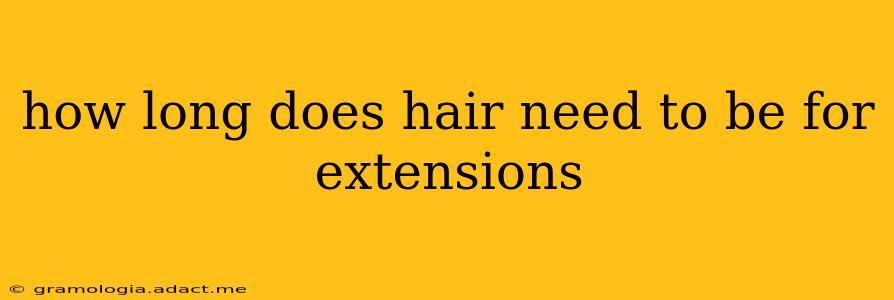Considering hair extensions? It's exciting to imagine the possibilities of longer, fuller hair, but before you book that appointment, you need to know if your current hair length is suitable. The minimum length required depends largely on the type of extensions you choose, your hair type, and the desired look. Let's dive into the specifics.
What are the different types of hair extensions?
Before we discuss length requirements, it's important to understand the various types of hair extensions available. Each method has its own criteria for minimum hair length. Common types include:
- Clip-in extensions: These are the easiest to apply and remove, requiring minimal commitment. They generally require the least amount of natural hair length.
- Tape-in extensions: These extensions use adhesive tape to bond wefts of hair to your natural hair. They typically need slightly longer hair than clip-ins.
- Sew-in extensions (weaves): These extensions are sewn onto cornrows or braids. They require significantly more natural hair length than other methods.
- Fusion/Micro-link extensions: These individual strands are bonded to your natural hair using a heat or adhesive method. They require a moderate amount of hair length.
- Keratin bond extensions: Similar to fusion extensions, these use keratin to bond individual strands to your natural hair. The length requirement is comparable to fusion extensions.
How long does my hair need to be for clip-in extensions?
Clip-in extensions are the most forgiving when it comes to hair length. Generally, you only need at least 4-6 inches of natural hair for clip-ins to blend effectively. Shorter hair might work, but the extensions might be more noticeable, and achieving a seamless blend could be more challenging. The more hair you have, the better the extensions will blend.
How long does my hair need to be for tape-in extensions?
Tape-in extensions require a bit more length than clip-ins. Most stylists recommend having at least 4-6 inches of hair, although some might be comfortable working with slightly shorter hair depending on its thickness. The goal is to have enough hair to securely sandwich the tape-in wefts without causing damage or discomfort. Thicker hair will generally handle tape-ins better than thin hair.
How long does my hair need to be for sew-in extensions (weaves)?
Sew-in extensions, or weaves, demand the most hair length. You'll generally need at least 6-8 inches of natural hair to create secure braids or cornrows that will effectively hold the wefts. Shorter hair might not provide enough anchorage, leading to slippage and discomfort. The longer and thicker your natural hair, the better the results and longevity of the weave.
How long does my hair need to be for fusion/micro-link extensions?
Fusion and micro-link extensions usually require at least 4-6 inches of hair length. However, the thickness of your hair is also a key factor. Fine or thin hair might benefit from slightly longer hair to distribute the weight of the extensions evenly. The extensions are attached individually, so shorter hair might be visible.
How long does my hair need to be for keratin bond extensions?
Keratin bond extensions have similar length requirements to fusion/micro-link extensions. You will typically need at least 4-6 inches of hair. This ensures that the bonds are properly concealed and that the extensions blend seamlessly with your natural hair. Thicker hair is generally preferable for better support and longevity.
What factors other than length affect extension suitability?
Beyond length, several other factors influence whether you're a good candidate for hair extensions:
- Hair thickness: Thicker hair provides a better base for extensions, making them less noticeable and easier to blend.
- Hair texture: Matching the texture of the extensions to your natural hair is crucial for a natural look.
- Hair health: Damaged or unhealthy hair might not be strong enough to support extensions.
- Lifestyle: Consider how much time and maintenance you're willing to dedicate to caring for your extensions.
Conclusion: Consult a professional stylist
Ultimately, the best way to determine if you have enough hair for extensions and which type is right for you is to consult a professional and experienced hair stylist. They can assess your hair, discuss your goals, and recommend the best option to achieve the desired look while protecting the health of your natural hair. Remember, always prioritize the health and integrity of your own hair.
